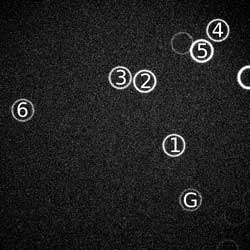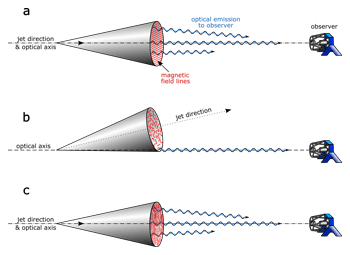LT Detects 10% Optical Polarisation in Gamma-Ray Burst
1800 GMT 09 December 2009A team of astronomers from Liverpool John Moores University (LJMU) have used the RINGO instrument on the Liverpool Telescope (LT) to measure the polarisation of light from a Gamma Ray Burst (GRB) and show that strong magnetic fields are responsible for beaming the light towards Earth.
Director of Liverpool Telescope Prof. Iain Steele explained: "We realised a few years ago that optical polarisation was going to be a vital discriminator between theoretical models of GRB formation, and developed the RINGO instrument specifically to study this question." The team's results are reported in a paper in the 10th December 2009 issue of Nature.
Gamma Ray BurstsGRBs form when the core of a massive star collapses or two neutron stars merge together. The resulting explosions are the brightest events in the universe, vastly outshining entire galaxies containing hundreds of billions of stars. The energy output is believed to be largely concentrated in a jet however, rather than spread out in all directions. A GRB event is detected if the Earth happens to lie within the beam direction of its jet.
Just such an event was detected on 2nd January 2009 by the NASA Swift satellite when it observed a 27-second burst of gamma rays from what was to be named GRB 090102. The position of the burst was determined automatically by the spacecraft, and the coordinates were immediately communicated to ground-based facilities over the internet. The LT automatically overrode its current observation and slewed to the GRB coordinates, to obtain a RINGO image 161 seconds after Swift triggered the alert.
 RINGO image of GRB 090102 observed 2009 Jan 02. The field of view is 4.6x4.6 arcmin. The optical afterglow of the GRB is the ring labelled "G"; foreground comparison sources are labelled 1-6. © 2009 LT Group.
RINGO image of GRB 090102 observed 2009 Jan 02. The field of view is 4.6x4.6 arcmin. The optical afterglow of the GRB is the ring labelled "G"; foreground comparison sources are labelled 1-6. © 2009 LT Group.Click for bigger (71KB).
RINGO uses a rotating Polaroid to modulate the incoming beam, followed by corotating deviating optics that spin each star image into a ring on the CCD. Any polarisation in the light is mapped out around the ring, and can be detected by measuring brightness changes around the circumference. Follow this link for further details on RINGO.
Six foreground objects were also observed in the same field. In the figure at right they are labelled 1-6 while the GRB itself is labelled "G". The measured optical (4600-7200 Å) polarisation of the GRB is P = 10.2 ± 1.3%, while that of the foreground objects is only 1-4%. Statistical analysis shows there is only a 0.1% chance of such a polarisation occurring randomly.
InterpretationSeveral possible models exist that predict polarisation in GRB afterglows. One model ("c" below) assumes magnetic instabilities in the shock front giving rise to independent ordered magnetic field patches; the polarised radiation would come from a number of these patches. The 10% polarisation observed by RINGO however is at the extreme upper limit of what would be expected from such a model, so this scenario seems unlikely.
Another situation that could give rise to polarised light from a GRB is if the observer's line of sight lies along the edge of the jet (see "b" below). In this case the magnetic fields parallel and perpendicular to the shock front could have different strengths, producing a polarised signal. However, the observed fall-off of brightness with time (the "light curve") does not follow that expected if we were observing along the edge of the jet. Also, the polarisation expected in this scenario would only be a few percent, not the 10% observed.
 Competing models of GRB magnetic field structure for standard fireball model: (a) large-scale ordered magnetic field threaded through the GRB outflow; (b) tangled magnetic field in shock front and line of sight close to jet edge, and (c) shock front contains some independent patches of locally-ordered magnetic fields. © 2009 LT Group.
Competing models of GRB magnetic field structure for standard fireball model: (a) large-scale ordered magnetic field threaded through the GRB outflow; (b) tangled magnetic field in shock front and line of sight close to jet edge, and (c) shock front contains some independent patches of locally-ordered magnetic fields. © 2009 LT Group.Click for bigger (44KB).
The model that best fits the observations ("a", right) suggests large-scale magnetic fields present throughout the relativistic outflow, originating from the start inside the "central engine" driving the explosion and accelerating and collimating the jet. The RINGO observations and light curve measurments made by the LT and other facilities after the burst agree with the predictions of this model.
ImpactThis is the first time such a measurement has been made within a few minutes of the explosion. Dr Shiho Kobayashi of the LJMU GRB research team explained "Theoreticians have been predicting that such a magnetic field is generated in the central fireball and it accelerates GRB jets to almost the speed of light. Now the existence of strong magnetic fields has been shown to be correct. Further RINGO observations will shed light on the acceleration process."
Leader of the LJMU GRB team Prof. Carole Mundell added "This important result gives us new insight into the physics of these remarkable objects and is a testament to the close collaboration between observers, theoreticians and technologists in the Liverpool and NASA Swift teams. It's incredible to think that the GRB discovery and our measurement process − from first detection and notification by NASA's Swift satellite to the polarisation measurement using RINGO on the Liverpool Telescope − took place completely automatically within less than three minutes and with no human intervention!"
[See also http://www.nasa.gov/mission_pages/swift/bursts/magnetic-power.html]


